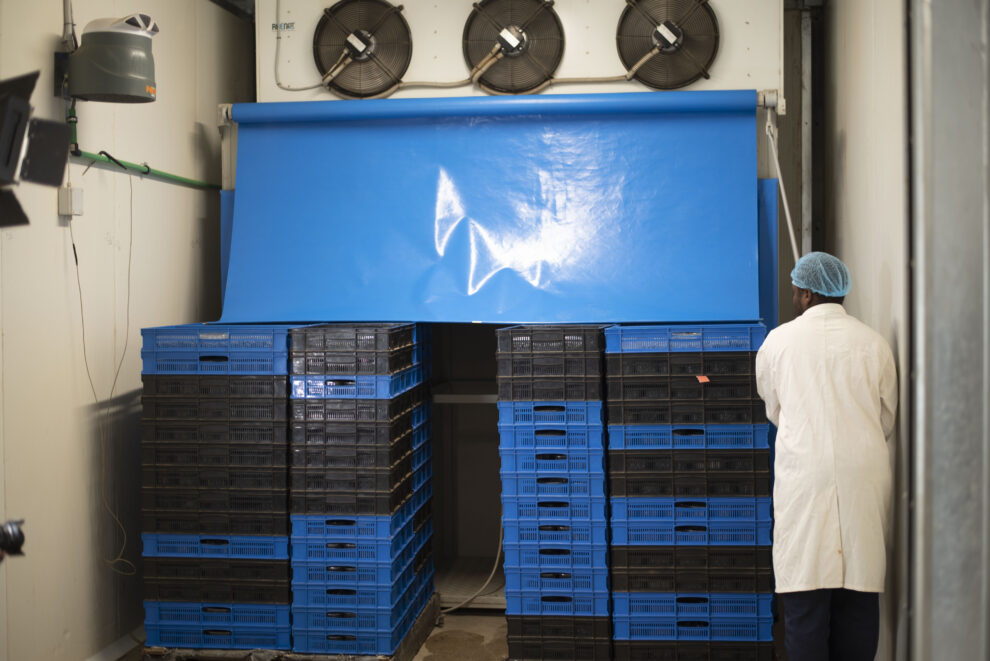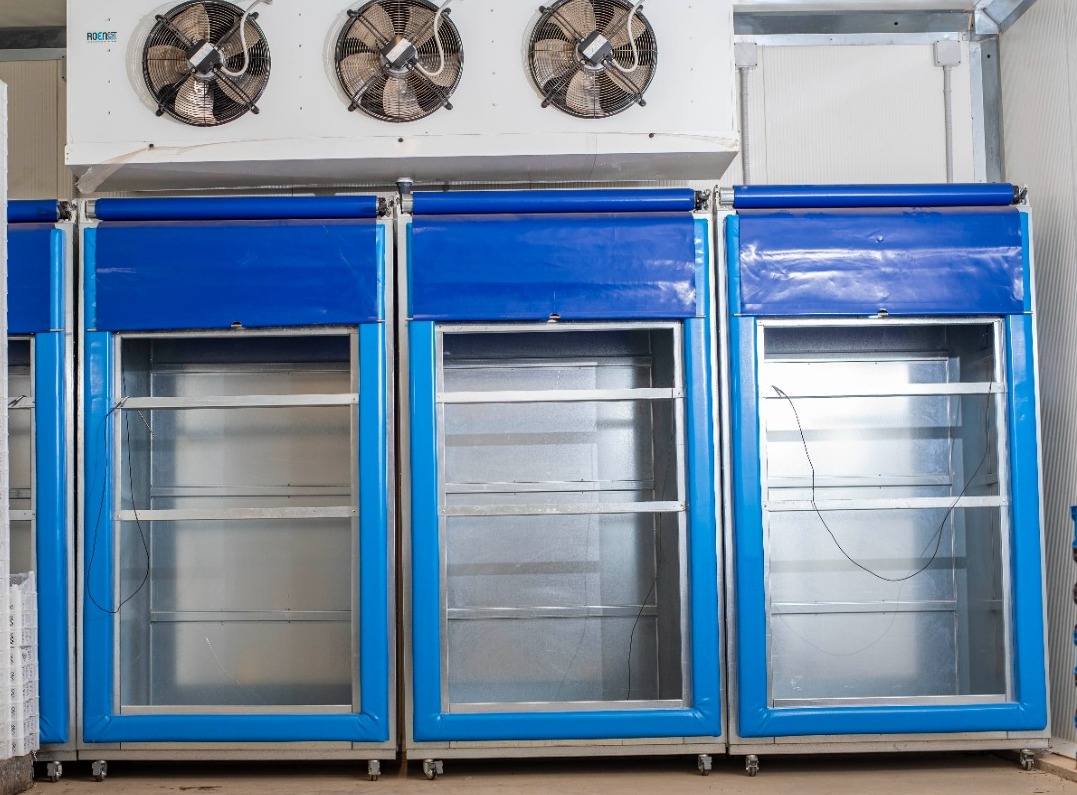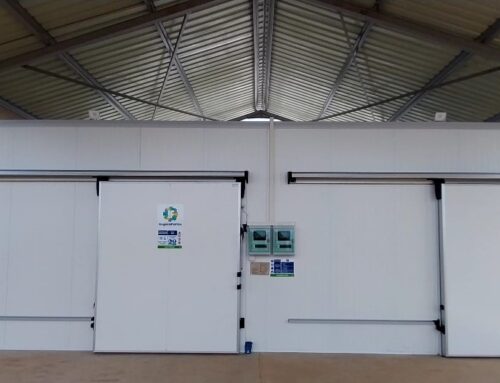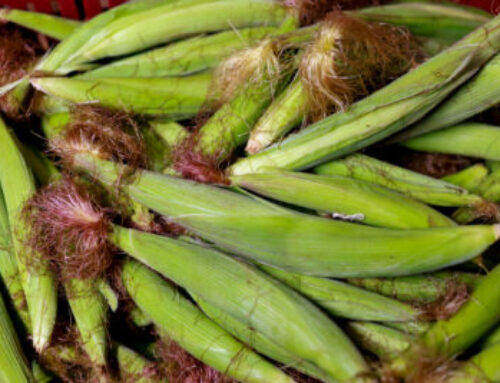Energy efficient precooling solutions: The Suction Box
Whether you are a flower, vegetable or fruit exporter, stabilizing product temperature as quickly as possible is fundamental for obtaining the shelf-life and quality required to enter and compete in retail and export markets. Precooling is the process of quickly removing heat to decrease this temperature rapidly, down to the expected core temperature of the fresh produce. Usually, precooling is the first step post-harvest and is recommended immediately following harvest to minimize spoilage. In turn, this rapid pre-cooling and then maintaining it at a constant low-temperature storage will extend the shelf life for most produce.
Many post-harvests experts state that an hour’s delay in the precooling of highly perishable produce reduces product shelf life by one day. The result is similar on produce exposure to high temperatures, even for as little as one hour, which can reduce shelf life by a full day. The impact of heat post-harvest cannot be understated, as studies show that food decay may increase twice or thrice as faster, with every 10 ◦C increase in temperature. On the other hand, reducing storage temperatures by 10 ◦C in the first hours after harvest will double or triple the shelf life of fresh horticultural products.
Pre-cooling is a key step for products such as blueberries, avocados, green beans, brussels sprouts, cherries, kiwi, nectarines, okra, bell peppers, plums, summer squash, strawberries, tomatoes, flowers and more. While certain crops can be stored without pre-cooling, many farmers and exporters, aiming towards the best results, practice pre-cooling as an integral part of their post-harvest management. For many fresh produce importers across regions in Europe, precooling is regarded as an indispensable first step for sellers to meet the minimum export standards. Additionally, retailers within this region are increasingly setting expectation standards for minimum shelf life. For instance, fine bean exporters are expected to offer a minimum shelf-life of 3 to 4 days in-store, which would not be possible without efficient pre-cooling at the origin. Therefore, bringing the pulp down to optimal temperature in shortened times allows a better resistance to eventual breaks or temperature spikes in the cold chain that might happen, for instance, during logistics at loading.
InspiraFarms Cooling acknowledges and urges the adoption of efficient precooling solutions, and for this reason, has designed and deployed the most advanced, portable and affordable range of blast chillers and forced air precoolers across Africa.
Forced-air precooling of fruits, vegetables and flowers
Forced air cooling is one pre-cooling method, used mainly for bulk produce and palletized produce. It is also the most versatile and widely used of all precooling methods. During forced air cooling, chilled air is forced to flow around each piece of produce. This close contact of chilled air with the product results in rapid, even cooling throughout the mass of produce, making it reach every package on a pallet, crate or bin in a much shorter time.
Forced-air pre-cooling effectively increases shelf life by removing field heat faster than other conventional cooling methods. In turn, this can reduce cooling times by half or more, compared to only air room cooling. Producers who start their cooling process without pre-cooling, but rely only on room cooling, would usually take 6 to 12 hours, to reach optimal pulp temperature. On the other hand, with a forced air precooler, you can reduce that time drastically to between 1 to 4 hours, depending on the type of product being cooled.
InspiraFarms Cooling offers a range of forced-air pre-cooling machines, with a variety of pressures between 150 to 300pa and adjustable airflows, allowing it to match it with a range of cooling machines and to treat up to 20 pallets of product, depending on the crop and other conditions. The suction box is the cheapest and most portable of these precooling solutions, designed to be energy-efficient, easy to install and to move around as needed. It is the best solution for flowers and berry exporters and can be placed in your existing cold room to create a pre-cooling unit, within the same cold room. The suction box is the best-suited, entry-level solution for your precooling needs since it provides you with the flexibility to cool down each pallet independently at such a low cost.
The suction box consists of a forced-air system with a fan and condenser that, when turned on, pulls or forces the airflow on the centre section between the pallets, removing the heat through convection. Additionally, a tarp in the system is laid across the top and back of the packaging, allowing it to seal and keep the flow of cold air through the product, rather than around it. Each suction box is designed with an inverter-driven engine to minimise power use, and a set of temperature and pressure sensors to optimise your cooling treatments, increasing your shelf-life and allowing you to provide more value for exporters.

Some precooling benefits offered by the suction box
- The suction box is an entry-level and low-cost solution, with a quick return on investment. It allows you to quickly integrate high-quality pre-cooling in your operations with minimal investment and without necessarily modifying your current cooling infrastructure, as you can place it in your existing cold room.
- It is a relatively small single unit of equipment that contains a forced-air system, that offers all the capabilities for assuring high quality and efficient pre-cooling, such as a motorized roll-up tarp, electronic fans, and smart controller integrated. It does not require starting current.
- It allows you to manage specific temperatures and cooling times for pallets individually, providing flexibility in the cooling treatment of different batches.
- It is the most portable precooling solution, that you can move around your facilities as needed and be coupled with other forced-air precooling equipment for expanding capabilities as required in specific moments.
Usage and UX reported by our clients
1. Lauetta Enterprises, Blueberries in Zimbabwe
Lauetta Enterprises is an agribusiness in Zimbabwe, focusing on the production and export of blueberries. As the first-time growers of Costa genetics in Zimbabwe, they export to markets in Hong Kong, Europe, the UK and the Middle East. Lauetta aims to consistently deliver premium quality fruit to markets and in turn receive a premium return on investment. As it stands, they would have to maintain this quality from the field to these markets, despite the long transit journey of up to 13,000km, 72 hours by air freight and 35 days by sea freight. Due to this long transit, their cold chain infrastructure needs to be as efficient and as close to the areas of production as possible. With excellent pre-cooling. According to Allistar Campbell, the Managing Director, they needed to optimise their step-down temperature maintenance in the post-harvest handling and packing process. This would only be made possible with efficient precooling, of their suction boxes.
The InspiraFarms’ Cooling technical team came up with a design for a 240 square meter facility which included 2 pre-cooling units made up of suction boxes with forced-air-precooling, a temperature-controlled packing room and a finished product room to bring the final product temperature down to 0-1 degrees. Thanks to this chain, they have been able to improve their gross-to-net ratio, as far as pack-out is involved. He explains that, when they are processing and packaging a punnet of berries, they would have to overpack by 5%, to cater for dehydration. But, with better pre-cooling features, including a suction box, they have brought that down to 3%, presenting a 2% increase in revenue per punnet.
2. Auzmoz Farm Holdings, Litchis in Zimbabwe
Ausmoz Farm Holdings is a large commercial farm located in the Manica Province of Mozambique, about 40 km from the Zimbabwean border. Its main products are litchis and avocados for export. Initially, they used refrigerated containers as an entry-level cooling solution before export. This worked well when volumes were initially low, with about 20 tonnes over a 20-days of harvest and shipment. However, when volumes increased, from their 2018 harvest, these facilities were proven not to be efficient in cooling capaity or adequate in size. As a result, the fruit was not effectively cooled prior to shipment, and much of it developed mould or started to rot, driving rejections due to unmarketability. The lack of proper pre-cooling immediately after harvest did not make things any better.
In 2019, Ausmoz invested in an InspiraFarms Cooling modular and prefabricated cold room of 60 square meters, with a suction box for pre-cooling capabilities through air-forced cooling, a humidifier, and a set of sensors and data systems.
According to them, “Pre-cooling the fruit quickly and to the right temperature allowed us to maintain optimal quality and significantly reduced losses resulting in high praise for the quality of our produce,” says Andrew Macpherson, Managing Director of Ausmoz Farm holdings.”



